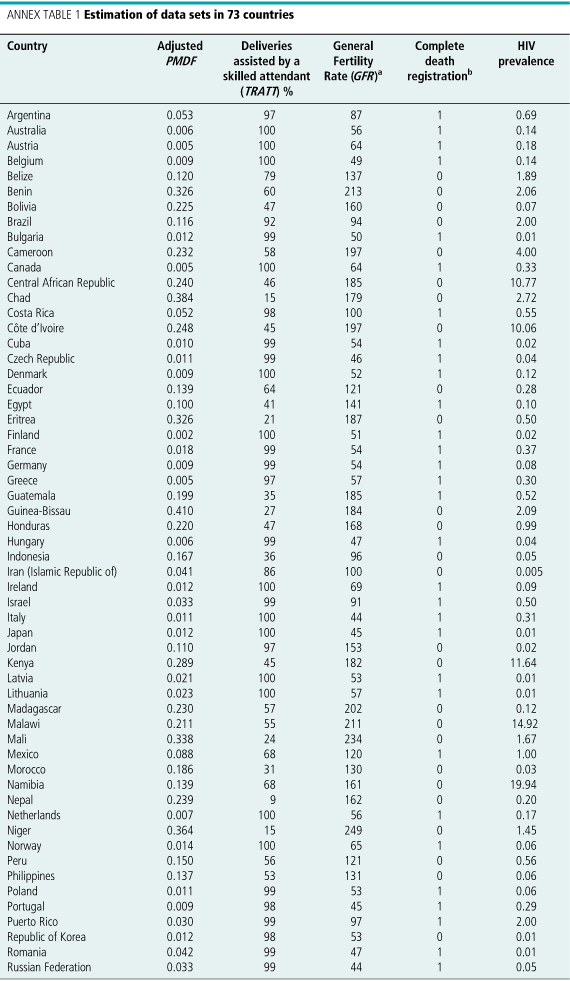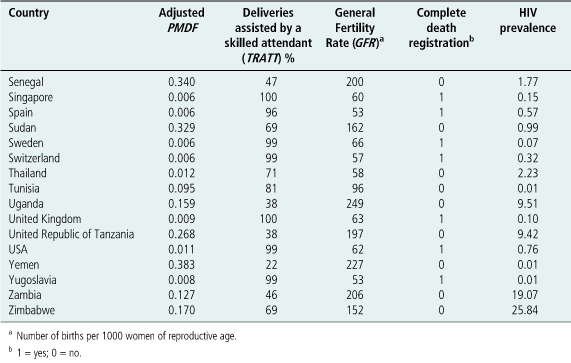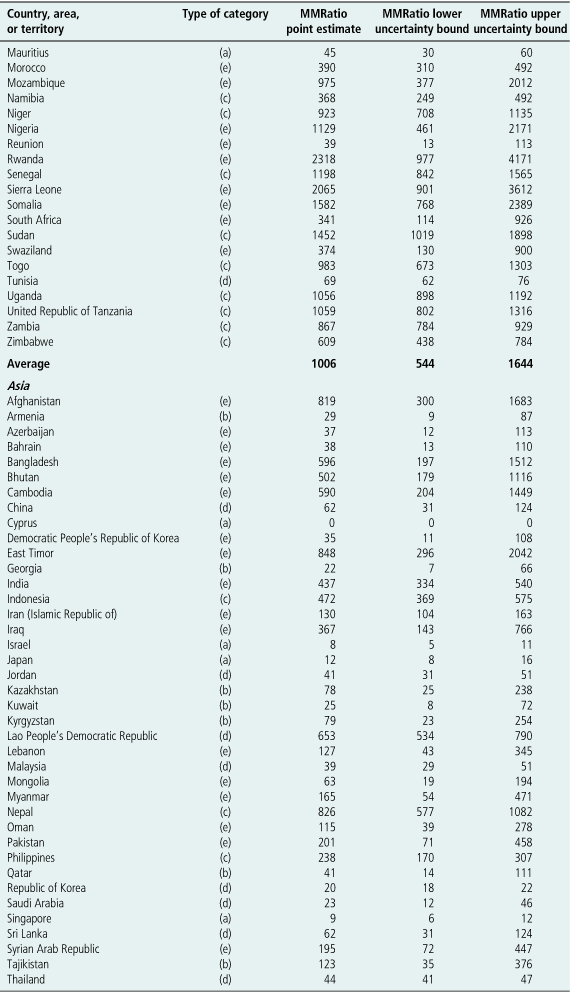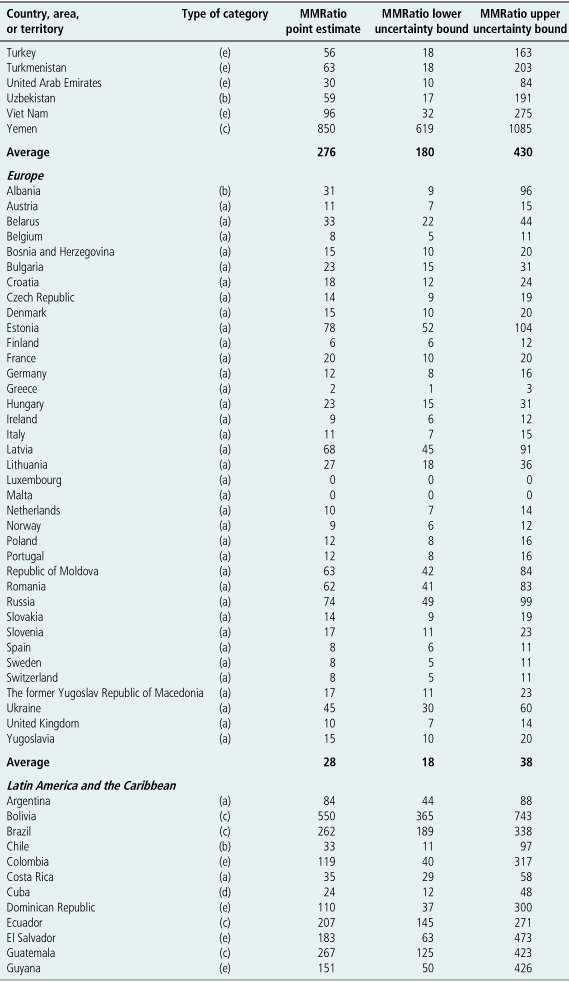Research
Estimates of maternal mortality for 1995
Kenneth Hill,1 Carla AbouZahr,2 & Tessa Wardlaw3
OBJECTIVE: To present estimates of maternal mortality in 188 countries, areas, and territories for 1995 using methodologies that attempt to improve comparability.
METHODS: For countries having data directly relevant to the measurement of maternal mortality, a variety of adjustment procedures can be applied depending on the nature of the data used. Estimates for countries lacking relevant data may be made using a statistical model fitted to the information from countries that have data judged to be of good quality. Rather than estimate the Maternal Mortality Ratio (MMRatio) directly, this model estimates the proportion of deaths of women of reproductive age that are due to maternal causes. Estimates of the number of maternal deaths are then obtained by applying this proportion to the best available figure of the total number of deaths among women of reproductive age.
FINDINGS: On the basis of this exercise, we have obtained a global estimate of 515 000 maternal deaths in 1995, with a worldwide MMRatio of 397 per 100 000 live births. The differences, by region, were very great, with over half (273 000 maternal deaths) occurring in Africa (MMRatio: >1000 per 100 000), compared with a total of only 2000 maternal deaths in Europe (MMRatio: 28 per 100 000). Lower and upper uncertainty bounds were also estimated, on the basis of which the global MMRatio was unlikely to be less than 234 or more than 635 per 100 000 live births. These uncertainty bounds and those of national estimates are so wide that comparisons between countries must be made with caution, and no valid conclusions can be drawn about trends over a period of time.
CONCLUSION: The MMRatio is thus an imperfect indicator of reproductive health because it is hard to measure precisely. It is preferable to use process indicators for comparing reproductive health between countries or across time periods, and for monitoring and evaluation purposes.
Keywords: Maternal mortality/statistics; Statistics/methods; Models/statistical (source: MeSH).
Mots clés: Mortalité maternelle/statistique; Statistique/méthodes; Modèle statistique (source: INSERM).
Palabras clave: Mortalidad materna/estadística; Estadística/métodos; Modelos estadísticos (fuente: BIREME).
Introduction
Maternal mortality is notoriously difficult to measure (1). The most widely used measure, the Maternal Mortality Ratio (MMRatio), expresses maternal deaths per 100 000 live births, but MMRatios rarely exceed 1000 or 1 per 100 live births. Maternal deaths are thus relatively rare events and they are also hard to identify precisely, both of which limit the applicability of sample survey measurement methods. In countries with well-developed statistical services, the conventional source of information about maternal mortality is the civil registration system, which records both live births and deaths, by cause, on a continuous basis. Even in such settings, however, maternal deaths are invariably found to be under-recorded in official statistics owing to misclassification of the cause of death (24). In countries with less well developed statistical services, the outright omission of deaths contributes an additional source of error.
Despite the difficulties in measuring maternal mortality, interest in obtaining estimates has increased. The MMRatio varies by a factor of over 100 between the highest and lowest mortality settings, making it the health outcome with the largest gap between developed and developing countries. Interest has also increased because one of the main targets of the Programme of Action, which was developed at the International Conference on Population and Development in Cairo in 1994 (5), is reproductive health. One specific goal of the Programme of Action called for quantified reductions in maternal mortality. However, although the goal was phrased in terms of a 1990 baseline, no global estimates of the situation in 1990 were available. To try to bridge the gap between the need for reliable data and the quality of conventional data sources, alternative approaches to measurement have been explored.
In 1996,WHO and UNICEF prepared model-based estimates of maternal mortality for about the year 1990 in developing countries, for which adequate empirical information had not been identified (6, 7). The model caused considerable controversy, particularly in countries which did have relevant information and for which the model-based estimates were often substantially higher than the existing figures. The resulting controversy, however, had at least three positive outcomes: 1) it increased general awareness of the problems surrounding the measurement of the MMRatio; 2) it drew attention to the various strengths and weaknesses of the different measurement approaches; and 3) it brought to light relevant data hitherto unavailable to the international community, or stimulated new data collection, or both. This paper updates the 1996 exercise using a revised methodology, incorporating new data as available, and presents the maternal mortality estimates, by countries and regions, for 1995.
The basis of the estimates
The estimation strategy was developed in response to concerns in three major areas, which were expressed in international forums about the 1996 exercise: 1) failure to use country data where they were available and which are believed to be of good quality; 2) concern about the choice of a dependent variable in the statistical model; and 3) rigidities in the model that limited the range of possible values of estimates of maternal mortality (811).
For the present estimation exercise, every attempt was made to use country data where available and of adequate quality. Using the available data, countries, areas, and territories were placed in one of the following six categories, according to whether they had:
(a) complete death registration data, with generally good cause of death attribution;
(b) complete death registration data, but uncertain cause of death attribution;
(c) information from a survey on deaths of sisters, with timing of death related to pregnancy;
(d) recent results from a Reproductive Age Mortality Study (RAMOS);
(e) other available relevant data;
(f) no relevant data available for a recent period.
Different strategies were used to arrive at estimates for the countries in each category, taking advantage of the stronger elements of the data while minimizing the distortions resulting from data errors.
Despite increased data availability, estimates for countries in categories (b) and (f) still require a statistical model to estimate the MMRatio. The model is fitted to country observations deemed to be of very high quality, using predictor variables that are available for almost every country, and is then used to predict estimates for countries that lack high quality information.
Choice of a dependent variable for the statistical model
A model using the proportion of deaths of women of reproductive age due to maternal causes (PMDF), rather than the MMRatio, has several advantages. First, the estimated PMDF is bounded by 0 and 1, so that its logit (ln{PMDF/(1-PMDF)}) can be modelled without risk of the predicted values falling outside that range. The predicted PMDF can then be applied to an envelope of deaths of women of reproductive age, obtained either from death registration data or from special tabulations of deaths, by age and sex, provided by the United Nations Population Division (UNPD) from the 1998 revision of World Population Prospects (12), to estimate the number of maternal deaths. Thus, the estimates have to be consistent with other demographic information about the population in question. Second, the PMDF estimate makes full use of limited data. For example, in category (b) countries with good overall death registration but uncertain cause-of-death reporting, a model-based estimate of PMDF can be applied to the envelope of registered female deaths, modelling only the distribution of such deaths by cause, not their number.
Third, sisterhood data, the most frequently available type of information about maternal mortality in high-mortality settings, are likely to provide more robust measures of the PMDF than of the MMRatio. A large majority of nationally representative data sets on sister survival, mostly collected under the auspices of the Demographic and Health Surveys (DHS) programme, have used sibling history to collect the basic data. Each of a respondents siblings is listed, and survival status is recorded. For sisters who died at age 12 or older, further questions are asked as to whether she was pregnant, or giving birth, or within two months of the end of a pregnancy when she died. These questions are used to identify possible maternal deaths; strictly speaking, it is a time-of-death (pregnancy-related) definition, not a cause-of-death (maternal) definition. Some non-maternal deaths are included, but some true maternal deaths are likely to be excluded because the respondent may not be aware of a sisters pregnancy at the time of death. The extent to which these two errors cancel out is not known with certainty (13, 14), but it is unlikely that the net error is large. Consequently, the PMDF can be expected to be estimated with reasonable accuracy.
Sisterhood estimates of the MMRatio, on the other hand, depend both on the classification of deaths as pregnancy related or otherwise and on the completeness of reporting of the sisters deaths. Certain features of the data raise questions about this completeness. The sibling history format allows the calculation of mortality rates for defined time periods before the survey. In an analysis of 15 DHS data sets (15), the estimates of female mortality between the ages of 15 and 50 years were higher for the period 06 years before the survey than for the period 713 years before the survey in a large majority of countries. These increases were not paralleled by increases in mortality in other age ranges, such as under the age of 5 years. Thus the sisterhood data indicated implausible recent increases in adult female mortality in most of the countries studied. Despite these differences in mortality level, the PMDF remained remarkably stable across time periods. A more likely explanation than rising mortality is data error, either an omission of sister deaths that occurred further back in the past, or misdating of such deaths and transferring them into a more recent period. Either way, one can have little confidence that the level of mortality for the period 06 years before the survey is accurate. This conclusion is reinforced by a comparison of sisterhood estimates with estimates from other sources. For most countries, there are no alternative sources of estimates, but in four cases (Guatemala, the Philippines, Senegal and Zimbabwe) it has been possible to compare the sisterhood estimates of adult mortality with independently validated alternative estimates. In all four, sisterhood data underestimated recent adult mortality, by amounts ranging from 15% to 60% (16).
These findings suggest that sisterhood data tend to underestimate overall mortality, particularly for periods further back in the past, and that, in the absence of counterbalancing errors, the MMRatios from sisterhood estimates are likely to be too low. The nature of these possible biases in the sisterhood estimates argue for using such data in the form of PMDFs rather than MMRatios.
One technical problem has to be addressed before using the sisterhood PMDFs. The PMDF shown in DHS country reports is calculated as the number of pregnancy-related deaths of sisters divided by the overall number of sister deaths. However, the distributions of sister deaths and of sister-years of exposure by age are not the same as the corresponding distributions in the actual population (17). For example, the sisters of reproductive age of respondents aged 1519 years are likely to be, on average, older than the respondents (they cannot be younger than 15, but they can be 20 or older), whereas the sisters of reproductive age of respondents aged 4549 years are likely to be generally younger. Years of exposure of sisters are thus concentrated in the central ages of the reproductive period at the expense of the extremes. However, it is also in the central ages that most births, and therefore most maternal deaths, are likely to occur. Thus, the reported PMDF is likely to be higher than the true PMDF would be for a group of women distributed by age in the same way as the actual population. In order to allow for this effect, age-standardized PMDFs were calculated, which can appropriately be applied to the number of deaths of women of reproductive age to estimate the number of maternal deaths.
The use of information from RAMOS studies also argues for the use of the PMDF rather than the MMRatio in the modelling exercise. RAMOS studies typically use a variety of data sources to try to get as complete a count of the number of deaths as possible, and of the maternal deaths among the deaths. However, RAMOS studies do not typically go to great lengths to check the numbers of births to use as the denominator of the MMRatio. Thus RAMOS studies, even though they tend to report their results in terms of the MMRatio, are by design more likely to obtain unbiased estimates of the PMDF.
Choice of independent variables
The choice of independent variables is constrained by the need to use only variables that are available for the vast majority of countries in the world around the year 1995. Given the nature of the dependent variable, the first predictor variable that has to be included is an indicator of fertility: the higher fertility (for a given maternal mortality risk per birth), the higher the number of maternal deaths, and the higher the PMDF. Since PMDF is calculated on the basis of the age distribution of women aged 1549 years, the appropriate fertility measure is the General Fertility Rate (GFR).
Socioeconomic variables are constrained by their limited availability, but it was possible to include both female literacy and per capita income in purchasing power parity terms. Neither variable retained significance, however, once other variables were included, although colinearity was high.
As an indicator of the role of health services, TRATT, the percentage of deliveries assisted by a skilled attendant i.e. a physician, nurse, or professionally-trained midwife) was included in the model. Given the widespread consensus that maternal mortality will not be significantly reduced if the appropriate management of obstetric complications is absent, this variable comes closest to capturing such access while being widely available from DHS and other surveys, and compiled into a database by WHO and UNICEF.
The HIV/AIDS epidemic can be expected to have important effects. A major increase in female adult mortality resulting from the epidemic would tend to reduce the PMDF by increasing the other causes of death (and perhaps by reducing fertility). Failure to take this epidemic into account would thus result in a model that would overestimate PMDF in countries badly affected by the epidemic, and would tend to underestimate the PMDF elsewhere. Country-specific estimates of HIV prevalence for 1995 (HIVAIDS) from UNAIDS were therefore incorporated in the model.
A variety of variables reflecting data quality were tried, but the variable ultimately used was a dummy variable identifying a country with death registration reported to the United Nations to be complete (goodVR). Two dummy variables for region, one identifying countries of formerly socialist Europe (FSE) and the other identifying countries of Latin America, Africa, West and South Asia (LASSAME) were also included.
Selection of cases for model fitting
National estimates of maternal mortality were carefully reviewed on a case-by-case basis, and only adequately documented estimates, backed by clear descriptions of acceptable methodology, were included in the data set to which the model was fitted. In some cases, adjustments were made to the dependent variable before fitting the model. For countries with documented assessments of completeness of recording of maternal deaths (Argentina, Costa Rica, Finland, France, Mexico, the Netherlands, New Zealand, and the United Kingdom), that estimate of the coverage was used to inflate the observed values. PMDFs for other statistically developed countries with registration-based estimates were inflated by a uniform factor of 1.5a (7). Estimates of PMDF derived from sisterhood data were age-standardized as noted above. Estimates derived from RAMOS studies were not adjusted. Independent variables were also carefully reviewed where possible. In particular, estimates of the proportion of deliveries assisted by medically-trained professionals were reviewed country by country.
In all, the model was fitted to 73 contemporary observations, 30 of which were for industrialized countries or countries of formerly socialist Europe. The data set, excluding variables that did not prove to be significant, is shown in Annex Table 1 (available on our web site: http://www.who.int/bulletin).
The final model
The final model, fitted using a robust regression approach that underweights the observations with large residuals,bis shown below. Values in parentheses under the coefficients show the t-values; all except the HIVAIDS variable were significant at the 1% level or better. The HIVAIDS variable was close to statistical significance at the 10% level, and its coefficient had the expected sign. Including this variable in the model was judged the most appropriate way of avoiding possible prediction bias that might result from inflated numbers of non-maternal HIV-related deaths The robust regression does not provide a direct R2 for this model, but Ordinary Least Squares regression gave very similar parameter estimates with an R2 of 0.919 and a Root Mean Square Error of 0.51. A plot of predicted values of PMDF plotted against observed values (not shown) does not indicate departure from the standard assumptions of regression analysis.

Estimates of maternal mortality for 1995
Maternal mortality estimates for countries with a population of 300 000 or more are shown as MMRatios in Tables 1(a) to 1(f) on the basis of data source, following the typology described earlier. The ways in which final values were arrived at vary from one country to another according to the countrys data availability category, as follows.
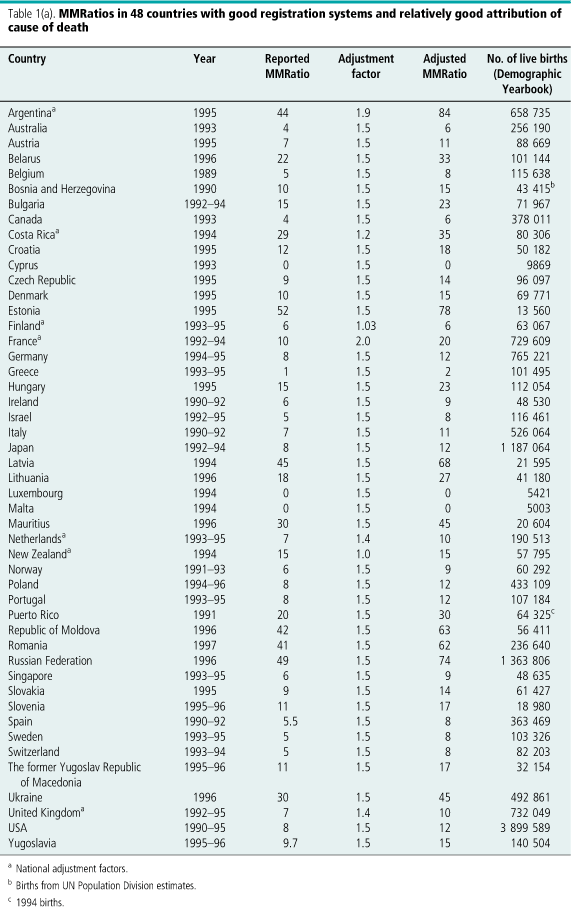
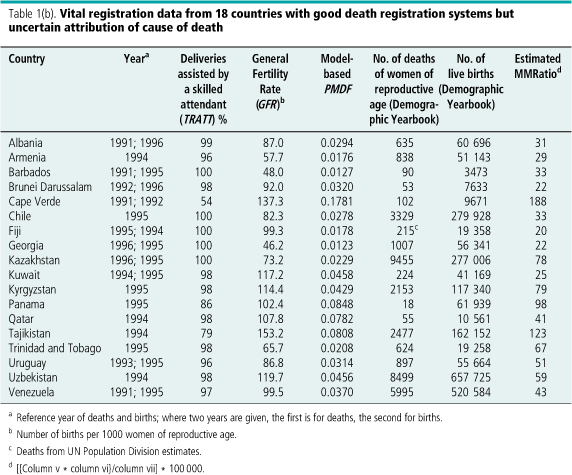
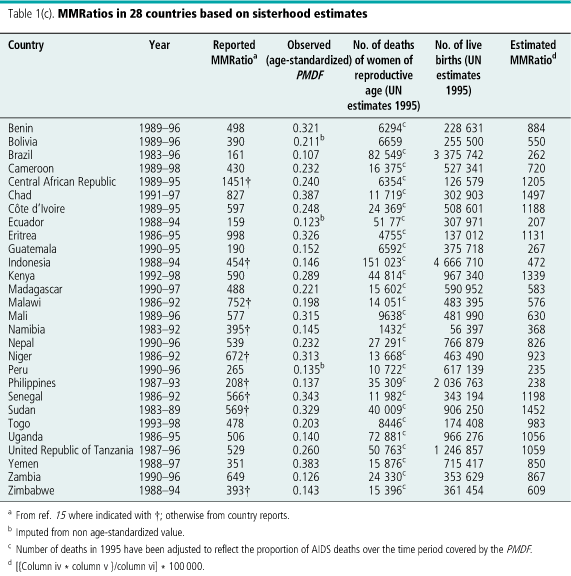
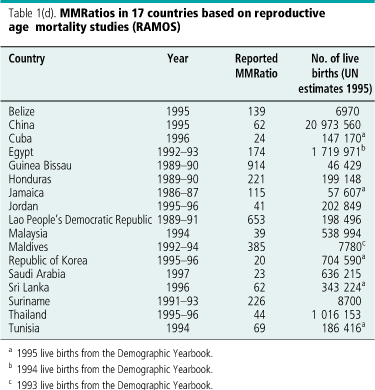
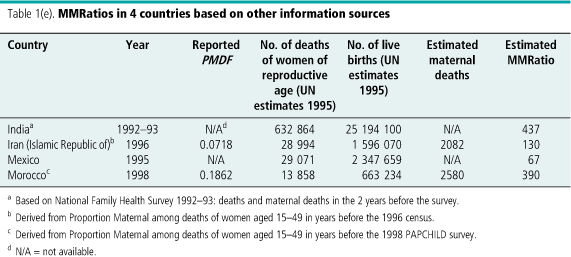
For the 48 countries in category (a), theMMRatios were based on the reported values adjusted by a factor that was in most cases 1.5. These estimates, with the actual adjustment factors used, are shown in Table 1(a).
For the 18 countries in category (b) based on complete death registration but questionable cause of death data the PMDF was estimated from the model, and applied to the appropriate envelope of female deaths to estimate the number of maternal deaths; the MMRatio was obtained by dividing by the registered number of live births. The results for these countries are shown in Table 1(b).
The 28 countries in category (c) based on direct sisterhood estimates are listed in Table 1(c). Each age-standardized PMDF from the sisterhood data was applied to the number of deaths among females aged 1549 years, indicated in the United Nations Estimates and Projections (1998 Revision) (18) for the year 1995. There were two exceptions to this treatment. For Zimbabwe, a review of data on household deaths by age from the 1992 Population Census suggested that the data were of good quality; the sisterhood PMDF was therefore applied to the Census estimate of the numbers of deaths of women of reproductive age. The second exception concerns countries with sisterhood estimates and with substantial AIDS mortality. The sisterhood PMDFs apply to a time period earlier than 1995. For the United Republic of Tanzania, for example, the PMDF covers a period from 1987 to 1996. The number of female deaths in this country rose steeply in the early 1990s as a result of the AIDS epidemic. Applying the 198796 PMDF to the 1995 deaths would therefore overestimate the number of maternal deaths. For all countries with substantial numbers of AIDS deaths, the United Nations estimates of non-AIDS and AIDS deaths for 198590 and 199095 were used to estimate the proportion, p, of all deaths of females of reproductive age that were due to AIDS over the period of time covered by the sisterhood PMDF (assuming a linear trajectory for AIDS deaths). The United Nations estimate of non-AIDS deaths in 1995 was then divided by (1p) to approximate the number of deaths (both AIDS and non-AIDS) there would have been in 1995, had the AIDS deaths equalled their average proportion over the period covered by the sisterhood PMDF. The observed PMDF was then applied to this adjusted number of 1995 deaths.
Seventeen countries in category (d) based on RAMOS-type studies are shown in Table 1(d), the observed MMRatio being assumed to be correct. The estimated numbers of live births for 1995, generally taken from United Nations estimates, were used to obtain the number of maternal deaths for calculation of regional summaries.
Among the four countries in category (e) based on miscellaneous data sources shown in Table 1(e), India carried out a major household survey, the National Family Health Survey (NFHS), in 199293 in collaboration with the Demographic and Health Surveys programme. The NFHS collected information on household deaths in the two years before the survey, and used the time of death relative to pregnancy to identify maternal deaths. The NFHS report (19) does not give enough information to evaluate the resulting MMRatio in detail, but the reported value was consistent with other sources and was used. Iran carried out a national census in 1996 which included questions on household deaths in the year before the interview. Households reporting a death of a woman of reproductive age were revisited and the results of a verbal autopsy were used, in conjunction with information from local health facilities, to identify maternal deaths. Evaluation of the information on deaths suggested substantial omissions, but the proportion of maternal deaths among the reported female deaths should be of RAMOS-type quality. Thus the reported PMDF was applied to the United Nations estimate of deaths of women of reproductive age in 1995 to arrive at an estimate of maternal deaths, from which the MMRatio was estimated using the United Nations estimate of live births in 1995. In the case of Mexico, an evaluation of death registration and cause-of-death reporting carried out by the Ministry of Health provided an estimate of the MMRatio. For Morocco, the 1998 PAPCHILD survey included questions on deaths in the household in the year before the survey, and further questions concerning the time of death relative to pregnancy for deaths of women of reproductive age. Detailed data from the survey are not available to the authors at present, but the estimated level of overall female adult mortality appears surprisingly low, so the reported PMDF was applied to the United Nations estimates of deaths in 1995, following the same procedure as for Iran.
The 55 countries in category (f), which were lacking an acceptable basis for a national estimate of maternal mortality, are listed in Table 1(f). The general procedure for these countries was to use the regression model to predict PMDF, which was then applied to the deaths of women of reproductive age in 1995 to estimate the number of maternal deaths. The MMRatio was then obtained by dividing the number of maternal deaths by an estimate of the number of births in 1995. In almost all cases, the overall numbers of births and deaths were obtained from the United Nations estimates.
Exceptions to the general procedure were made for two countries, Rwanda and Liberia, which were affected in the early 1990s (but not around 1995) by civil strife. For these countries the annual deaths during the civil strife were abnormally high, and the number of maternal deaths would be only slightly inflated, if at all. Accordingly the model-estimated PMDF was applied to an estimate of deaths in the absence of strife. For both these countries, deaths in the absence of strife were assumed equal to the annual deaths between 1995 and 2000.
The results presented in Tables 1(a) to 1(f) are summarized in Table 2. On the basis of this exercise, the estimated number of maternal deaths in 1995 for the world was 515 000. Of these deaths, over half (272 500) occurred in Africa, about 41% (217 500) occurred in Asia, about 4% (22 000) in Latin America and the Carribean, and less than 1% (2700) in Europe and North America. In terms of the MMRatio, the world figure was estimated to be 397 per 100 000 live births. By region, the MMRatio was highest for Africa (1006), followed by Asia (276), Latin America (190), Oceania (119), Europe (28), and North America (11).

The country with the highest estimated number of maternal deaths was India (110 000), followed by Ethiopia (46 000), Nigeria (45 000), Indonesia (22 000), the Democratic Republic of the Congo (20 000), Bangladesh (20 000), the United Republic of Tanzania (13 000), Sudan (13 000), China (13 000), and Kenya (13 000). These ten countries account for 61% of all maternal deaths. To be included in this list, however, is partly a function of having many births, since the number of maternal deaths is the product of the numbers of births and the risk per birth. On a risk-per-birth basis, the countries with the highest MMRatios were all in Africa; the top ten, in rank order, were Rwanda, Sierra Leone, Burundi, Ethiopia, Somalia, Chad, Sudan, Côte dIvoire, Equatorial Guinea, and Burkina Faso. In all, there were 22 countries in sub-Saharan Africa with MMRatios in excess of 1000. Apart from Haiti, no country elsewhere in the world has a value in excess of 900.
Uncertainty bounds
The estimates of MMRatio presented in Tables 1(a) 1(f) have a wide margin of uncertainty. Even in countries with highly developed statistical systems, the MMRatios are thought to be underestimates by a substantial margin, and they have been inflated by 50% in the present study. However, we do not know if 50% is correct the true figure could be higher or lower. The other categories of estimates also have their margins of uncertainty e.g. sampling errors for RAMOS studies and DHS estimates of PMDF, and prediction errors for the modelled PMDFs. For each data category, we have attempted to determine the uncertainty boundaries around the estimated value, within which the true figure is likely to lie. These are not confidence intervals in the statistical sense, because there are errors involved that cannot be quantified in a rigorous probabilistic manner. However, they do give a sense of the magnitude of the possible errors involved. Each data category was treated differently.
For the countries with well-developed statistical systems in category (a), the lower confidence bound on the MMRatio is the official figure, and the upper confidence bound is twice the official figure. The point value usually lies halfway between.
For countries in category (b), with complete death registrations but uncertain cause of death classification, the upper and lower confidence bounds were based on plus or minus two standard errors of the model prediction of the logit of the PMDF.
For countries in category (c), based on sisterhood data, the survey estimate of the 95% confidence intervals around the recorded PMDF (15) was generally used. In a subset of cases, no survey estimate was available, and had to be estimated on the basis of the sample size of the survey and the relation between sample size and standard error observed for surveys with the necessary data. These estimates actually have additional errors, not quantifiable and not included in the confidence bounds, around the United Nations estimates of female deaths and births.
For countries in category (d), based on RAMOS studies, the published standard errors around the point estimate of the MMRatio were used where possible, and guesstimates derived from the reported sample size were used when no published figure was available. Actual errors were probably higher than those published, because of error in the estimates of live births used.
For countries in category (e), based on miscellaneous sources, the published confidence intervals were used where available; where they were not available, the uncertainty bounds were approximated from published information on sample size.
For countries in category (f), a model based on estimates of PMDF applied to United Nations estimates of the numbers of deaths, the standard error of the prediction of the logit of the PMDF was used to obtain the uncertainty bounds, as in the case of category (b) countries. The uncertainty bounds only reflect the errors in the model predictions; they do not take into account possible errors in the United Nations estimates.
Annex Table 2 (available on our web site: http://www.who.int/bulletin) shows for each country, area, or territory the category into which it falls, the point estimate of the MMRatio, and the upper and lower uncertainty bounds. Summaries (shown in Table 2) were obtained simply by averaging individual country values. It is likely, however, that compensating errors at the area level make the point estimates by area more precise than individual country estimates.
The uncertainty bounds are extremely wide. At the global level, the lower uncertainty bound is for a MMRatio of 234, with an annual total of some 303 000 maternal deaths, and the upper uncertainty bound is for a MMRatio of 635, with an annual total of some 822 000 maternal deaths. For countries with high point estimates derived from the model, the spread between the low and the high bounds is very wide. For example, the range for Rwanda, the country with the highest point estimate of 2318, is from 977 to 4171. Countries with low point estimates derived from the model have an even wider relative range; for example, the United Arab Emirates has a point estimate of 30, but the range is from 10 to 84. Country comparisons need to be made very cautiously, taking into account the very large range of uncertainty around the point estimates.
Discussion
The maternal mortality estimates presented in this paper are, for the most part, based on directly relevant country-specific information. Table 1(f), which lists the countries with the weakest empirical basis, represents only 55 countries (with 26% of the total of world births in 1995) out of the 170 countries with populations of over 300 000 for which estimates were made. Basic data have also been adjusted for countries in other data categories, however. For countries with highly developed statistical systems (see Table 1(a), with a total of 48 countries contributing 11% of total world births), the recorded maternal deaths were typically inflated by 50%. For countries with good coverage of deaths, but uncertain quality concerning attribution of the cause of death (see Table 1(b), with 18 countries accounting for 2% of total world births), the model-predicted PMDF applied to registered deaths inflated the recorded MMRatio by a factor of up to five, although, on average, the adjustments were much smaller. For countries with direct sisterhood data (Table 1(c), with a total of 28 countries accounting for 17% of total world births) and for the Islamic Republic of Iran and Morocco (Table 1(e)) with direct observations of PMDF, the observed age-standardized PMDFs were applied to the United Nations estimates of deaths for 1995, with the result that the estimated MMRatios were substantially higher than the original sisterhood estimates, in many cases more than double; in only one case, Paraguay, did the estimated MMRatio fall below the sisterhood value. Only for countries with RAMOS studies (Table 1(d), with a total of 18 countries accounting for 21% of world births) and for New Zealand and India was an observed MMRatio used without adjustment.
The estimates of MMRatio given in Tables 1 and 2 are expressed per 100 000 live births. However, at least for high values, the accuracy is substantially less than the number of digits shown. There are a number of sources of potential error in the estimates.
First, the model may be incorrect, affecting the results in Tables 1(b) and 1(f). The data points to which the model is fitted have wide confidence intervals, and rather arbitrary adjustments have been made to many of the points. However, it is encouraging that the model fits the observations well, and is robust for the inclusion or exclusion of different types of observation.
Second, extrapolation of the model beyond the range of observations to which it is fitted to populations with more extreme values of the independent variables may be inappropriate.
Third, there may be variables missing from the model which influence the outcome, or the fact that countries have enough data to be part of the estimation data set may be associated with the outcome.
Fourth, the observed values of independent variables used to predict PMDFs may be incorrect.
Fifth, the envelope to which the PMDF is applied, deaths of women of reproductive age, may be incorrect, particularly if derived from United Nations estimates and projections.
Finally, the number of births used as the denominator of the MMRatio may also be wrong.
The exercise does, however, confirm that maternal mortality is a major problem in many areas. It is unlikely that there are fewer than 303 000 maternal deaths globally a year, or that the average worldwide MMRatio is less than 234. It is also unlikely that there are more than 822 000 maternal deaths globally a year, or that the average worldwide MMRatio is more than 635. Maternal mortality is a particularly serious problem in sub-Saharan Africa, which includes 22 of the 23 countries with national MMRatios estimated to be 1000 or more.
The wide margins of error inherent in all the estimates of MMRatio presented here, regardless of the statistical sophistication of the country, indicate that comparisons of this indicator between countries or across time are not necessarily valid. In particular, the results of the present and the 1996 exercise should not be compared on a country basis, and no conclusions should be drawn about trends, since both the methodology and the base data have changed since the 1996 exercise. Apart from the data and methodology changes, the uncertainty bounds around point estimates are so wide that even large apparent changes may not be statistically significant. In the absence of comprehensive and high quality registration of vital events, the MMRatio is too hard to measure to be programmatically useful. Greater effort should be directed to developing indicators of maternal health that can be monitored regularly and compared across populations and over a period of time. A number of process indicators have been proposed (20), such as coverage of essential obstetric care, the proportion of births by Caesarean section, or the proportion of deliveries assisted by skilled attendants. These measures are of value for programme design and monitoring in their own right, and are also, to the extent that they are correlated with maternal mortality, indirect indicators of outcome. Though each measure has its own problems, the judicious use of breakdowns into subpopulations and the use of locally appropriate definitions and standards offer opportunities for monitoring at the programme level which the MMRatio cannot match. 
Acknowledgements
Financial support for the development of these estimates was provided by WHO and UNICEF. The authors are grateful to Nyein Nyein Lwin (UNICEF) and Elizabeth Ahman (WHO) for assistance in compiling the databases for the development of these estimates. The authors would also like to thank Gareth Jones (UNICEF); Paul Van Look, Alan Lopez and Rafael Lozano (WHO); Ralph Hakkert, Richard Leete, and Mohammed Nizamuddin (UNFPA); Judith Fortney (Family Health International); and John Hobcraft (London School of Economics) for their contributions to the preparation of the 1995 estimates of maternal mortality.
Résumé
Estimations de la mortalité maternelle pour 1995
OBJECTIF: Présenter des estimations de la mortalité maternelle dans 188 pays, zones et territoires pour 1995 en utilisant des méthodes visant à améliorer la comparabilité.
MÉTHODES: Pour les pays qui possèdent des données directement applicables à la mesure de la mortalité maternelle, diverses procédures dajustement peuvent être utilisées selon la nature des données. Pour les pays qui manquent de telles données, les estimations peuvent être réalisées au moyen dun modèle statistique ajusté sur les informations des pays qui disposent de données jugées de bonne qualité. Ce modèle ne permet pas destimer directement le taux de mortalité maternelle mais il donne une estimation de la proportion de décès parmi les femmes en âge de procréer qui sont dus à des causes maternelles. On obtient une estimation du nombre de décès maternels en appliquant cette proportion au meilleur chiffre disponible du nombre total de décès chez les femmes en âge de procréer.
RÉSULTATS: Cet exercice a conduit à une estimation mondiale de 515 000 décès maternels en 1995, avec un taux mondial de mortalité maternelle de 397 pour 100 000 naissances vivantes. Il existe de très grandes différences dune région à lautre, plus de la moitié des décès maternels (273 000) survenant en Afrique (taux de mortalité maternelle : >1000 pour 100 000), contre 2000 seulement en Europe (taux de mortalité maternelle : 28 pour 100 000). On a également réalisé une estimation des limites inférieure et supérieure dincertitude doù lon a pu déduire que le taux mondial de mortalité maternelle nétait probablement pas inférieur à 234 ni supérieur à 635 pour 100 000 naissances vivantes. Ces limites et celles des estimations nationales sont si larges quil faut être très prudent lorsquon compare les données dun pays à lautre, et il nest pas possible de tirer des conclusions valables quant aux tendances sur une période déterminée.
CONCLUSION: Le taux de mortalité maternelle est donc un indicateur imparfait de la santé génésique car il est difficile de le mesurer avec précision. Il est préférable dutiliser des indicateurs de processus pour comparer la santé génésique dun pays à lautre ou au cours du temps et à des fins de surveillance et dévaluation.
Resumen
Estimaciones de la mortalidad materna para 1995
OBJETIVO: Presentar estimaciones de la mortalidad materna en 188 países, zonas o territorios para 1995 empleando metodologías concebidas para mejorar la comparabilidad.
MÉTODOS: Para los países que disponen de datos directamente pertinentes para la medición de la mortalidad materna, pueden aplicarse varios procedimientos de ajuste en función de la naturaleza de los datos empleados. En cuanto a los países que carecen de datos pertinentes, se pueden realizar estimaciones empleando un modelo estadístico ajustado a la información de los países que poseen datos considerados de buena calidad. Más que estimar la Razón de Mortalidad Materna (RMM) directamente, este modelo estima la proporción de defunciones entre las mujeres en edad reproductiva que se deben a causas maternas. El número de defunciones maternas se estima entonces aplicando esa proporción a la mejor cifra disponible del número total de defunciones entre las mujeres en edad reproductiva.
RESULTADOS: Mediante esta forma de proceder, hemos obtenido una estimación mundial de 515 000 defunciones maternas en 1995, con una RMM mundial de 397 por 100 000 nacidos vivos. Las diferencias entre regiones fueron muy considerables, registrándose más de la mitad de los casos (273 000 defunciones maternas) en África (RMM = >1000 por 100 000), frente a un total de sólo 2000 defunciones maternas en Europa (RMM = 28 por 100 000). Se estimaron asimismo los límites de incertidumbre inferior y superior, determinándose a partir de ese intervalo que era improbable que la RMM mundial estuviese por debajo de 234 o por encima de 635 por 100 000 nacidos vivos. Estos límites de incertidumbre y los de las estimaciones nacionales son tan amplios que hay que ser cautelosos a la hora de hacer comparaciones entre países, y no es posible extraer conclusiones válidas sobre las tendencias a lo largo de un periodo.
CONCLUSIÓN: Así pues, la RMM es un indicador imperfecto de la salud reproductiva, ya que es difícil medirlo con precisión. Es preferible emplear indicadores de procesos para comparar la salud reproductiva entre países o a lo largo de periodos y con fines de vigilancia y evaluación.
References
1. Campbell O, Graham W. Measuring maternal mortality and morbidity: levels and trends. London, Maternal and Child Health Epidemiological Unit, London School of Hygiene and Tropical Medicine, 1991: 26.
2. Bouvier-Colle MH et al. Reasons for the underreporting of maternal mortality in France, as indicated by a survey of all deaths among women of childbearing age. International Journal of Epidemiology, 1991, 20 (3): 717721.
3. Hibbard BM. Confidential enquiries into maternal deaths in the United Kingdom, 19881990. London, Department of Health and Social Security, 1994.
4. Smith JC et al. An assessment of the incidence of maternal mortality in the United States. American Journal of Public Health, 1984, 74: 780783.
5. Programme of Action adopted at the International Conference on Population and Development, Cairo, 513 September 1994. New York, United Nations,1994.
6. WHO/UNICEF. Revised 1990 estimates of maternal mortality: a new approach by WHO and UNICEF. Geneva, World Health Organization, 1996 (unpublished document WHO/FRH/MSM/ 96.11, UNICEF/PLN/96.1).
7. Stanton C et al. Modelling maternal mortality in the developing world. Unpublished background paper prepared for WHO and UNICEF, 1995.
8. WHO/UNICEF/UNFPA. Americas Region consultation on maternal mortality estimates, Washington DC, April 1998. Geneva, World Health Organization, 1998 (unpublished document WHO/RHT/98.27).
9. WHO/UNICEF/UNFPA. Asia Region Consultation on Maternal Mortality Estimates, Bangkok, Thailand, June 1998. Geneva, World Health Organization, 1998 (unpublished document WHO/ RHT/98.29)
10. Presented at Interregional consultation on maternal mortality measurement, monitoring and surveillance, July 1999, Geneva, World Health Organization.
11. WHO/UNICEF/UNFPA. The development of 1995 estimates of maternal mortality: peer review meeting, summary report and conclusions (unpublished).
12. World population prospects: the 1998 revision. New York, United Nations, 1999.
13. Stecklov G. Maternal mortality estimation: separating pregnancy-related and non-pregnancy-related risks. Studies in Family Planning, 1995, 26 (1): 3338.
14. Shahidullah M. The sisterhood method of estimating maternal mortality: the Matlab experience. Studies in Family Planning, 1995, 26 (2): 101106.
15. Stanton C, Abderrahim N, Hill K. DHS maternal mortality indicators: an assessment of data quality and implications for data use. Calverton, MD, Macro International Inc., 1997 (Demographic and Health Surveys Analytical Report No. 4).
16. Stanton C, Abderrahim N, Hill K. An assessment of DHS maternal mortality indicators . Studies in Family Planning, 2000, 31: 111123.
17. Hakkert R. Personal communication, 1999.
18. World population prospects: the 1998 revision. Special tabulations. New York, United Nations, 1999.
19. National family and health survey, India, 199293. Bombay, International Institute for Population Studies (IIPS), 1995.
20. UNICEF/WHO/UNFPA. Guidelines for monitoring the availability and use of obstetric services. New York, UNICEF, 1997.
1 Professor and Director, Hopkins Population Center, Johns Hopkins University, School of Hygiene and Public Health, 615 North Wolfe Street, Baltimore MD 21205-2179, USA. Correspondence should be addressed to this author.
2 Coordinator, Policy, Planning and Evaluation, Family and Community Health, World Health Organization, Geneva, Switzerland.
3 Senior Project Officer, Statistics and Monitoring, Division of Evaluation, Policy and Planning, UNICEF, New York, USA.
a The value of 1.5 was arrived at by averaging the results of studies of underreporting of maternal deaths in France, the United Kingdom, and USA.
b The rreg command in STATA was used.
Ref. No. 00-0865
